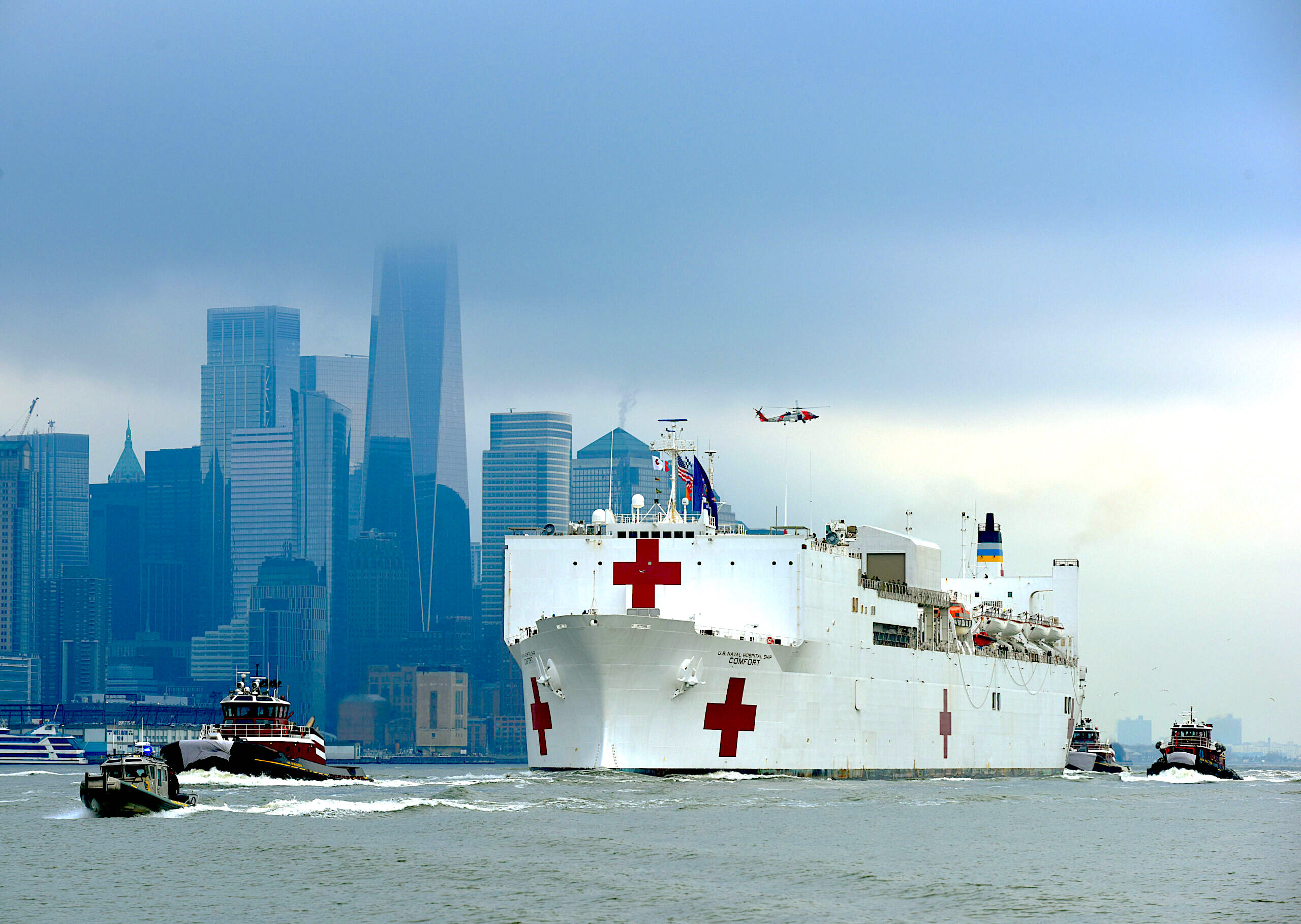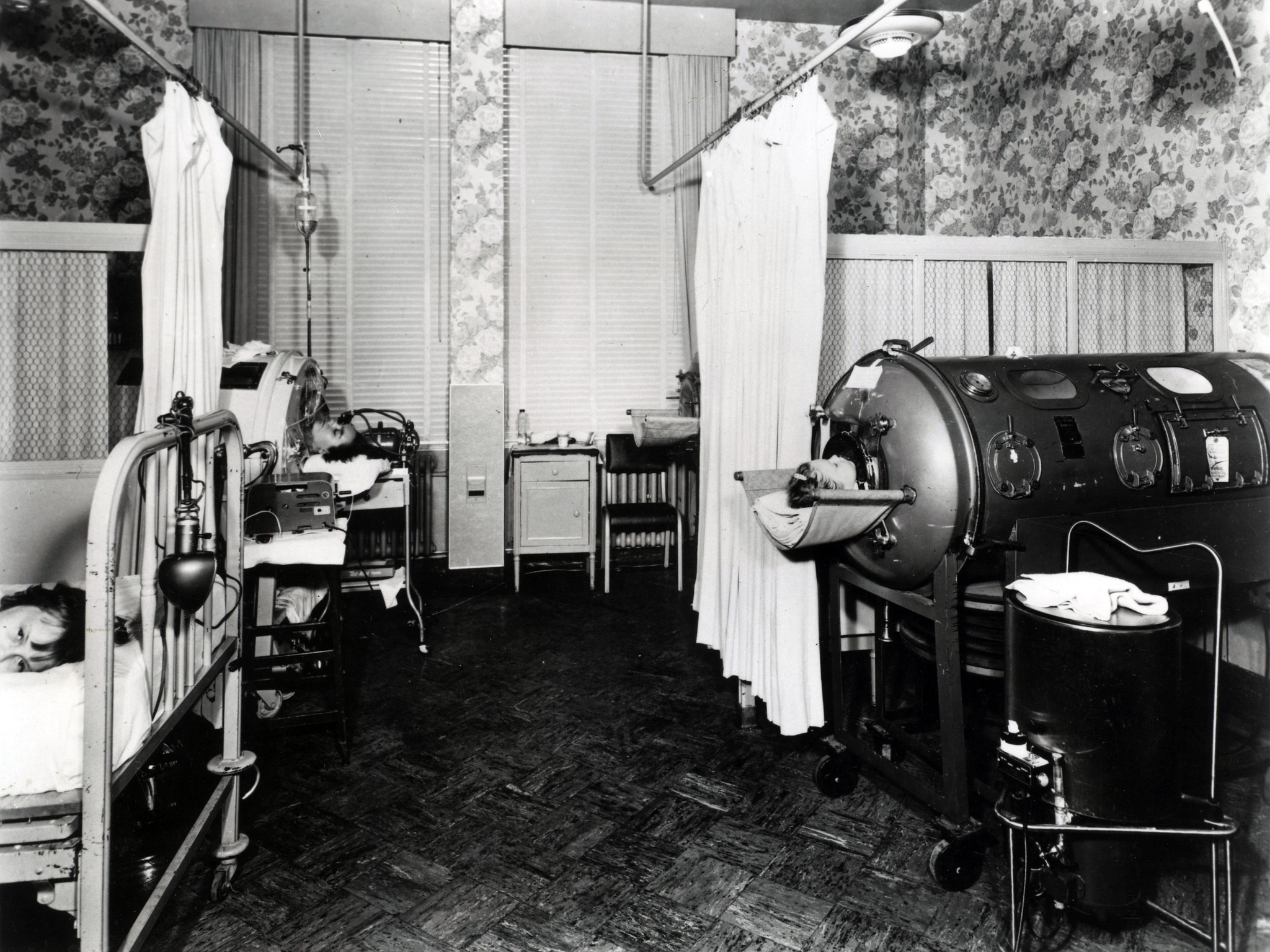During both, the truth can quickly disappear, writes Patrick Cockburn.

USNS Comfort arrives in New York on March 30, 2020, to assist the city’s Covid-19 response. (U.S. Coast Guard, John Q. Hightower)
By Patrick Cockburn
TomDispatch.com
 The struggle against Covid-19 has often been compared to fighting a war. Much of this rhetoric is bombast, but the similarities between the struggle against the virus and against human enemies are real enough. War reporting and pandemic reporting likewise have much in common because, in both cases, journalists are dealing with and describing matters of life and death. Public interest is fueled by deep fears, often more intense during an epidemic because the whole population is at risk. In a war, aside from military occupation and area bombing, terror is at its height among those closest to the battlefield.
The struggle against Covid-19 has often been compared to fighting a war. Much of this rhetoric is bombast, but the similarities between the struggle against the virus and against human enemies are real enough. War reporting and pandemic reporting likewise have much in common because, in both cases, journalists are dealing with and describing matters of life and death. Public interest is fueled by deep fears, often more intense during an epidemic because the whole population is at risk. In a war, aside from military occupation and area bombing, terror is at its height among those closest to the battlefield.
The nature of the dangers stemming from military violence and the outbreak of a deadly disease may appear very different. But looked at from the point of view of a government, they both pose an existential threat because failure in either crisis may provoke some version of regime change. People seldom forgive governments that get them involved in losing wars or that fail to cope adequately with a natural disaster like the coronavirus. The powers-that-be know that they must fight for their political lives, perhaps even their physical existence, claiming any success as their own and doing their best to escape blame for what has gone wrong.
My First Pandemic
I first experienced a pandemic in the summer of 1956 when, at the age of 6, I caught polio in Cork, Ireland. The epidemic there began soon after virologist Jonas Salk developed a vaccine for it in the United States, but before it was available in Europe. Polio epidemics were at their height in the first half of the 20th century and, in a number of respects, closely resembled the Covid-19 experience: many people caught the disease but only a minority were permanently disabled by or died of it. In contrast with Covid-19, however, it was young children, not the old, who were most at risk. The terror caused by poliomyelitis, to use its full name, was even higher than during the present epidemic exactly because it targeted the very young and its victims did not generally disappear into the cemetery but were highly visible on crutches and in wheelchairs, or prone in iron lungs.

In 1952, children in “iron lungs” populated many hospital wards. (FDA, Flickr)
Parents were mystified by the source of the illness because it was spread by great numbers of asymptomatic carriers who did not know they had it. The worst outbreaks were in the better-off parts of modern cities like Boston, Chicago, Copenhagen, Melbourne, New York and Stockholm. People living there enjoyed a good supply of clean water and had effective sewage disposal, but did not realize that all of this robbed them of their natural immunity to the polio virus.
The pattern in Cork was the same: most of the sick came from the more affluent parts of the city, while people living in the slums were largely unaffected. Everywhere, there was a frantic search to identify those, like foreign immigrants, who might be responsible for spreading the disease. In the New York epidemic of 1916, even animals were suspected of doing so and 72,000 cats and 8,000 dogs were hunted down and killed.
The illness weakened my legs permanently and I have a severe limp so, even reporting in dangerous circumstances in the Middle East, I could only walk, not run. I was very conscious of my disabilities from the first, but did not think much about how I had acquired them or the epidemic itself until perhaps four decades later. It was the 1990s and I was then visiting ill-supplied hospitals in Iraq as that country’s health system was collapsing under the weight of UN sanctions.
As a child, I had once been a patient in an almost equally grim hospital in Ireland and it occurred to me then, as I saw children in those desperate circumstances in Iraq, that I ought to know more about what had happened to me. At that time, my ignorance was remarkably complete. I did not even know the year when the polio epidemic had happened in Ireland, nor could I say if it was caused by a virus or a bacterium.
So I read up on the outbreak in newspapers of the time and Irish Health Ministry files, while interviewing surviving doctors, nurses, and patients. Kathleen O’Callaghan, a doctor at St. Finbarr’s hospital, where I had been brought from my home when first diagnosed, said that people in the city were so frightened “they would cross the road rather than walk past the walls of the fever hospital.”
My father recalled that the police had to deliver food to infected homes because no one else would go near them. A Red Cross nurse, Maureen O’Sullivan, who drove an ambulance at the time, told me that, even after the epidemic was over, people would quail at the sight of her ambulance, claiming “the polio is back again” and dragging their children into their houses or they might even fall to their knees to pray.
The local authorities in a poor little city like Cork where I grew up understood better than national governments today that fear is a main feature of epidemics. They tried then to steer public opinion between panic and complacency by keeping control of the news of the outbreak. When British newspapers like The Times reported that polio was rampant in Cork, they called this typical British slander and exaggeration. But their efforts to suppress the news never worked as well as they hoped.
Instead, they dented their own credibility by trying to play down what was happening. In that pre-television era, the main source of information in my hometown was the Cork Examiner, which, after the first polio infections were announced at the beginning of July 1956, accurately reported on the number of cases, but systematically underrated their seriousness.

Patrick’s Street, Cork’s main shopping street. (Dylan, CC BY-SA 4.0, Wikimedia Commons)
Headlines about polio like “Panic Reaction Without Justification” and “Outbreak Not Yet Dangerous” regularly ran below the fold on its front page. Above it were the screaming ones about the Suez Crisis and the Hungarian uprising of that year. In the end, this treatment only served to spread alarm in Cork where many people were convinced that the death toll was much higher than the officially announced one and that bodies were being secretly carried out of the hospitals at night.
My father said that, in the end, a delegation of local businessmen, the owners of the biggest shops, approached the owners of the Cork Examiner, threatening to withdraw their advertising unless it stopped reporting the epidemic. I was dubious about this story, but when I checked the newspaper files many years later, I found that he was correct and the paper had almost entirely stopped reporting on the epidemic just as sick children were pouring into St. Finbarr’s hospital.
The Misreporting of Wars and Epidemics
 By the time I started to research a book about the Cork polio epidemic that would be titled Broken Boy, I had been reporting wars for 25 years, starting with the Northern Irish Troubles in the 1970s, then the Lebanese civil war, the Iraqi invasion of Kuwait, the war that followed Washington’s post-9/11 takeover of Afghanistan, and the U.S.-led 2003 invasion of Iraq.
By the time I started to research a book about the Cork polio epidemic that would be titled Broken Boy, I had been reporting wars for 25 years, starting with the Northern Irish Troubles in the 1970s, then the Lebanese civil war, the Iraqi invasion of Kuwait, the war that followed Washington’s post-9/11 takeover of Afghanistan, and the U.S.-led 2003 invasion of Iraq.
After publication of the book, I went on covering these endless conflicts for the British paper the Independent as well as new conflicts sparked in 2011 by the Arab Spring in Libya, Syria and Yemen.
As the coronavirus pandemic began this January, I was finishing a book (just published), War in the Age of Trump: The Defeat of Isis, the Fall of the Kurds, the Confrontation with Iran. Almost immediately, I noticed strong parallels between the Covid-19 pandemic and the polio epidemic 64 years earlier.
Pervasive fear was perhaps the common factor, though little grasped by governments of this moment. Boris Johnson’s in Great Britain, where I was living, was typical in believing that people had to be frightened into lockdown, when, in fact, so many were already terrified and needed to be reassured.
I also noticed ominous similarities between the ways in which epidemics and wars are misreported. Those in positions of responsibility — President Donald Trump represents an extreme version of this — invariably claim victories and successes even as they fail and suffer defeats. The words of the Confederate general “Stonewall” Jackson came to mind. On surveying ground that had only recently been a battlefield, he asked an aide: “Did you ever think, sir, what an opportunity a battlefield affords liars?”
This has certainly been true of wars, but no less so, it seemed to me, of epidemics, as Trump was indeed soon to demonstrate (over and over and over again). At least in retrospect, disinformation campaigns in wars tend to get bad press and be the subject of much finger wagging. But think about it a moment: it stands to reason that people trying to kill each other will not hesitate to lie about each other as well.
While the glib saying that “truth is the first casualty of war” has often proven a dangerous escape hatch for poor reporting or unthinking acceptance of a self-serving version of battlefield realities (spoon-fed by the powers-that-be to a credulous media), it could equally be said that truth is the first casualty of pandemics. The inevitable chaos that follows in the wake of the swift spread of a deadly disease and the desperation of those in power to avoid being held responsible for the soaring loss of life lead in the same direction.
There is, of course, nothing inevitable about the suppression of truth when it comes to wars, epidemics, or anything else for that matter. Journalists, individually and collectively, will always be engaged in a struggle with propagandists and PR men, one in which victory for either side is never inevitable.
Unfortunately, wars and epidemics are melodramatic events and melodrama militates against real understanding. “If it bleeds, it leads” is true of news priorities when it comes to an intensive care unit in Texas or a missile strike in Afghanistan. Such scenes are shocking but do not necessarily tell us much about what is actually going on.
The recent history of war reporting is not encouraging. Journalists will always have to fight propagandists working for the powers-that-be. Sadly, I have had the depressing feeling since Washington’s first Gulf War against Saddam Hussein’s Iraq in 1991 that the propagandists are increasingly winning the news battle and that accurate journalism, actual eyewitness reporting, is in retreat.
Disappearing News
By its nature, reporting wars is always going to be difficult and dangerous work, but it has become more so in these years. Coverage of Washington’s Afghan and Iraqi wars was often inadequate, but not as bad as the more recent reporting from war-torn Libya and Syria or its near total absence from the disaster that is Yemen. This lack fostered misconceptions even when it came to fundamental questions like who is actually fighting whom, for what reasons, and just who are the real prospective winners and losers.
Of course, there is little new about propaganda, controlling the news, or spreading “false facts.” Ancient Egyptian pharaohs inscribed self-glorifying and mendacious accounts of their battles on monuments, now thousands of years old, in which their defeats are lauded as heroic victories. What is new about war reporting in recent decades is the far greater sophistication and resources that governments can deploy in shaping the news. With opponents like longtime Iraqi ruler Saddam Hussein, demonization was never too difficult a task because he was a genuinely demonic autocrat.
Yet the most influential news story about the Iraqi invasion of neighboring Kuwait in 1990 and the U.S.-led counter-invasion proved to be a fake. This was a report that, in August 1990, invading Iraqi soldiers had tipped babies out of incubators in a Kuwaiti hospital and left them to die on the floor. A Kuwaiti girl reported to have been working as a volunteer in the hospital swore before a U.S. congressional committee that she had witnessed that very atrocity. Her story was hugely influential in mobilizing international support for the war effort of the administration of President George H.W. Bush and the U.S. allies he teamed up with.
In reality it proved purely fictional. The supposed hospital volunteer turned out to be the daughter of the Kuwaiti ambassador in Washington. Several journalists and human rights specialists expressed skepticism at the time, but their voices were drowned out by the outrage the tale provoked. It was a classic example of a successful propaganda coup: instantly newsworthy, not easy to disprove, and when it was — long after the war — it had already had the necessary impact, creating support for the U.S.-led coalition going to war with Iraq.
In a similar fashion, I reported on the American war in Afghanistan in 2001-2002 at a time when coverage in the international media had left the impression that the Taliban had been decisively defeated by the U.S. military and its Afghan allies. Television showed dramatic shots of bombs and missiles exploding on the Taliban front lines and Northern Alliance opposition forces advancing unopposed to “liberate” the Afghan capital, Kabul.
When, however, I followed the Taliban retreating south to Kandahar Province, it became clear to me that they were not by any normal definition a beaten force, that their units were simply under orders to disperse and go home. Their leaders had clearly grasped that they were over-matched and that it would be better to wait until conditions changed in their favor, something that had distinctly happened by 2006, when they went back to war in a big way.
They then continued to fight in a determined fashion to the present day. By 2009, it was already dangerous to drive beyond the southernmost police station in Kabul due to the risk that Taliban patrols might create pop-up checkpoints anywhere along the road.
None of the wars I covered then have ever really ended. What has happened, however, is that they have largely ended up receding, if not disappearing, from the news agenda. I suspect that, if a successful vaccine for Covid-19 isn’t found and used globally, something of the same sort could happen with the coronavirus pandemic as well.
Given the way news about it now dominates, even overwhelms, the present news agenda, this may seem unlikely, but there are precedents. In 1918, with World War I in progress, governments dealt with what came to be called the Spanish Flu by simply suppressing information about it. Spain, as a non-combatant in that war, did not censor the news of the outbreak in the same fashion and so the disease was most unfairly named “the Spanish Flu,” though it probably began in the United States.
The polio epidemic in Cork supposedly ended abruptly in mid-September 1956 when the local press stopped reporting on it, but that was at least two weeks before many children like me caught it. In a similar fashion, right now, wars in the Middle East and north Africa like the ongoing disasters in Libya and Syria that once got significant coverage now barely get a mention much of the time.
In the years to come, the same thing could happen to the coronavirus.
Patrick Cockburn is a Middle East correspondent for the Independent of London and the author of six books on the Middle East, the latest of which is “War in the Age of Trump: The Defeat of Isis, the Fall of the Kurds, the Confrontation with Iran” (Verso).
This article is from TomDispatch.com.
The views expressed are solely those of the author and may or may not reflect those of Consortium News.
Please Contribute to Consortium News
on its 25th Anniversary
Donate securely with  PayPal here.
PayPal here.
Or securely by credit card or check by clicking the red button:


As good as I have read on Consortium News, thanks
Patrick. I am going to buy your new book. Participant as a child in Melbourne during the polio epidemic. Fortunately I didn’t catch it.
You are certainly right about the truth being suppressed in epidemics. In the spring of 1918 a new flu strain appeared in American Army camps and became more virulent later in that year. The news of it was suppressed because of wartime censorship until several cases appeared in neutral Spain, which did not practice press censorship. Only then did the general American public learn of the epidemic. It became known as the “Spanish Flu” and eventually killed more people than the war.
Disease generally has killed more soldiers than battles in War throughout history. It is only recently where it somehow became acceptable to target civilians as “collateral damage” that disease, still a major force in War, sometimes killed less than bombs and bullets.
There is a nice short article in Lancet “Deadly comrades: war and infectious diseases” by Connolly and Heymann (2002). While optimistic about the potential to stop disease in sub-Saharan Africa even with local tribal war, wonder if the WHO’s views have changed with the Forever American wars in Sudan and Somalia, on-going sanctions against Burundi and the Central African Republic, and covert actions through most of the central African belt of struggling nations? Probably this area will soon flame into a “new” hot spot. Must be many “American” resources there for exploitation.
I don’t know about the British Isles, but we just viewed the documentary “Unacknowledged” by Doctor Steven M. Greer, which presents evidence and testimony that the CIA infiltrated the major media in the U.S. to control news about UFOS and aliens, and coincidentally, about our human “enemies”. When I hear the uniform lines about all the evils committed against us by Russia and the failure to present opposing evidence, I think I see the fruits of CIA control.
There’s no way to know for sure yet, but I concur with Catherine Arnold in her 1918 pandemic book, that the virus originated in China, and the Chinese construction workers brought it to the West. That China claimed it had a suspiciously mild flu season that year, isn’t credible in my opinion and augurs for Arnold’s theory. And there is evidence precursors definitely existed before the U.S. outbreak.
1918 was the worst part of the Warlord Era. There was no real government in charge of much, just a lot if claimants.
Very enlightening. Thanx.
The US’s problem is that it is losing control of the narrative which exposes its lies, chicanery, deceit and fraud. This will cost the US trust and trust is a commodity that you can’t buy.
Worth remembering:
the Kuwaiti incubator propaganda coup was cooked up by Hill and Knowlton, an American public relations gang.
EXCELLENT
Thanks
Thank you, Patrick.
“since Washington’s first Gulf War against Saddam Hussein’s Iraq in 1991 that the propagandists are increasingly winning the news battle”
Even today, most Americans and “journalists” think that was a great war. Here is the truth:
see: The Dark Side of America’s Gulf War: youtube.com/watch?v=-2KpG9fFCc4
GW Bush’s oil company sold Kuwait the slant drill gear they used to siphon Iraq’s
oil knowing he would respond. GOP when in the WH always plans a military adventure. Reagan did Grenada, GHW did Gulf 1, W did Iraq. Nixon killed the Paris peace deal in ’68 all sides agreed to behind LBJ’s back to hurt Humphrey. KIA was 23,500. GOP sentenced 35000 to die for a campaign tactic. W sentenced 5,000 to die. and 500,000 Iraqis sentenced to die. They had more doctors per capita than America before we bombed their hospitals , clinics, and med schools.